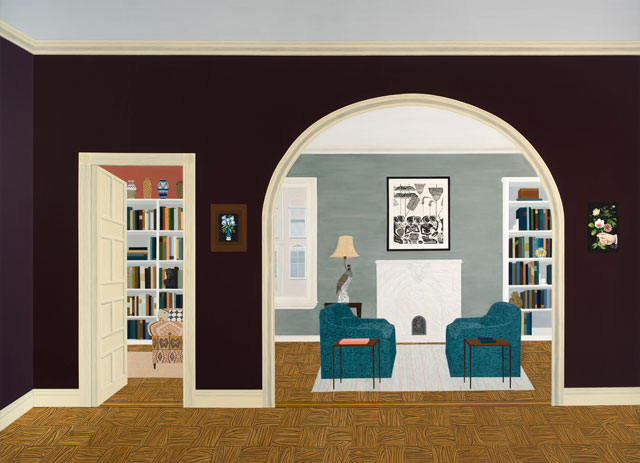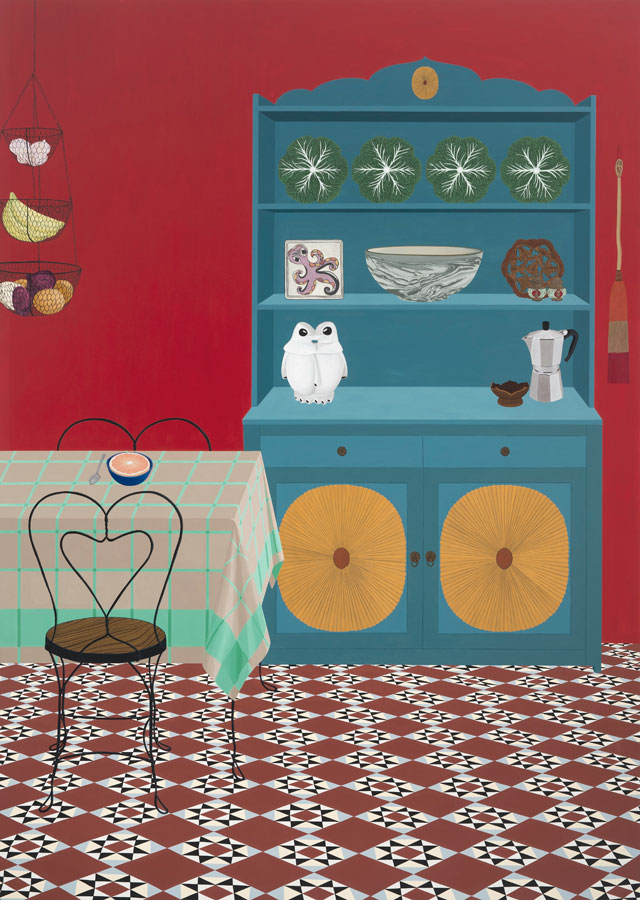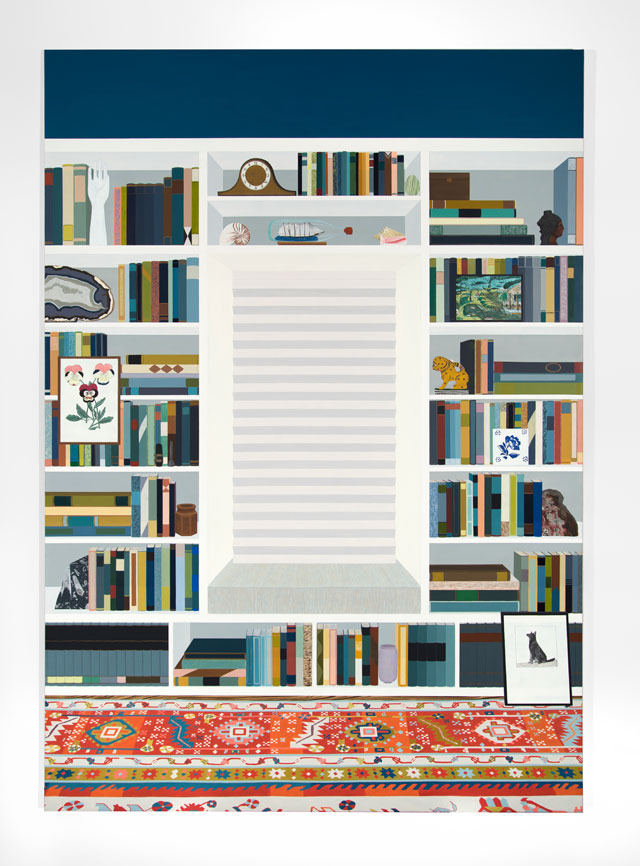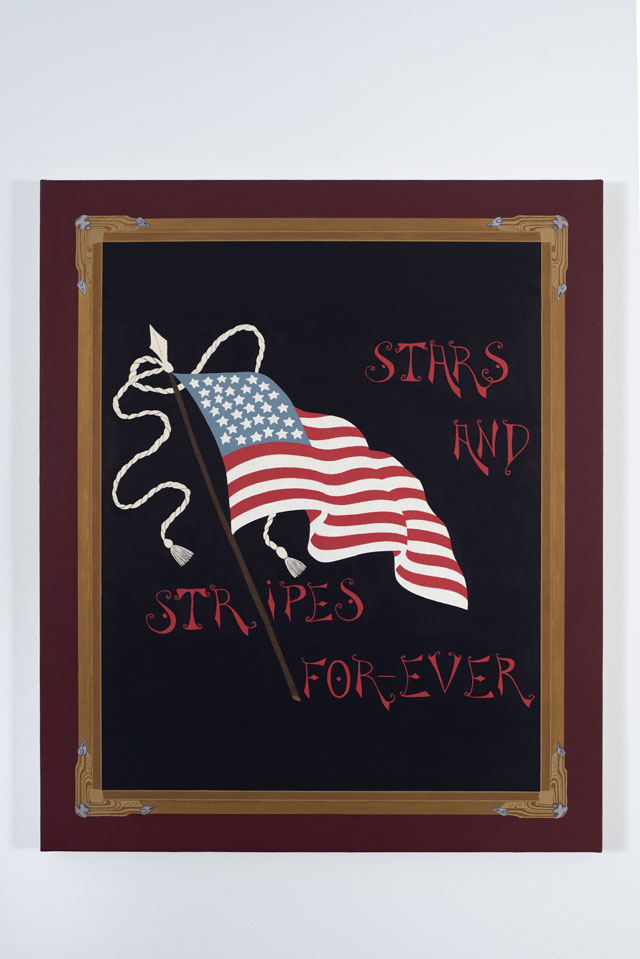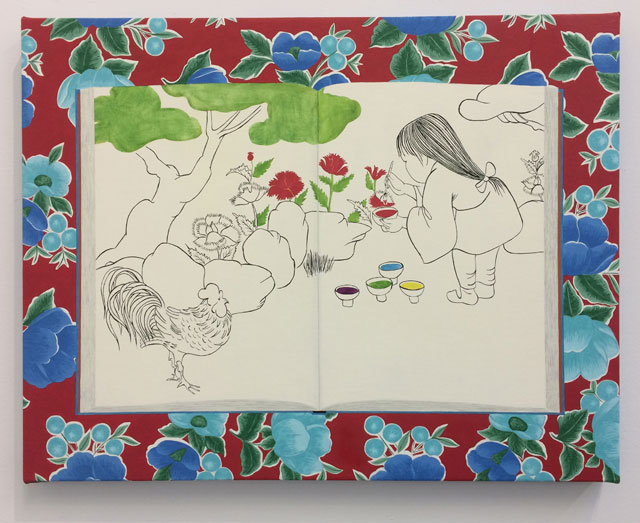

by ALLIE BISWAS
For her first solo museum exhibition in 2015, at the Institute of Contemporary Art at the University of Pennsylvania, Becky Suss (b1980, Philadelphia, Pennsylvania) made a body of work that was guided by her late grandparents’ mid-century suburban home. Her new series of paintings, currently on display at Jack Shainman Gallery in New York, continues to be led by the process of remembering, as well as interiors that include objects of personal significance. These enigmatic pictures, though, also veer for the first time into the space of the fictional and invented.
Suss received an MFA from the University of California, Berkeley, and a BA from Williams College, Massachusetts.
Allie Biswas: Can you tell me about your life in Philadelphia? You have lived there for most of your life, is that right?
Becky Suss: I grew up in the suburbs and then went away to school. I then moved back for five years, and during that time I made art and was part of a collective. After going to California for graduate school, I moved back to Philadelphia. I love it there. It’s where I'm from. I'm a big cheerleader for the city.
AB: What was it like making art as part of a collective?
BS: All my friends had stayed in Philadelphia while I went to college, so I went back a lot. I knew some people who were working as part of a group called Space 1026, which started as a skate park. It was a bunch of mainly guys who had gone to Rhode Island School of Design in the mid-90s. They moved back to Philadelphia and wanted a place where no one was going to kick them out at the end of the night. So they rented a place in Chinatown and all their friends came and helped them build it out. They started by building a small place to make paintings underneath the skating ramp, but eventually they took out the ramp and built a gallery in its place. I knew a lot of those guys, so after I finished college, I thought, I want to try to make art outside of school, so I’m going to go home, get a job as a bartender and just work. And that’s what I did. I worked all day, every day. I shared a studio area with three other artists. It was a great incentive to try to work out how to be an artist. I would wake up, go to the studio, then we would all work at the bar there in the evening. It was really a wonderful transition.
AB: So this time in your career strongly informed how you work as an artist now?
BS: That experience was one of the most important in terms of teaching me how to be an artist. It taught me discipline. I told myself that I had to work for at least four hours a day, every day. I treated it like a job.
AB: What was your reason for leaving Space 1026? Had you outgrown this way of working?
BS: I left the collective after about four years. It was wonderful, but it’s tough to be part of a collective because it also involves making lots of decisions as a group, and business things. But after returning to Philadelphia from graduate school, I joined another collective called Vox Populi. We would joke that if 1026 was the kid’s table, then Vox Populi was the grown-up collective. It had funding and an executive director; it would receive grants. Rather than have a studio, Vox Populi was more an opportunity to run a gallery and attend meetings. It was about talking about art. Then, eventually, I was ready to just be by myself.
AB: When did you first approach the idea of the domestic interior? Has this always been your subject?
BS: Before the interior, I was making lots of landscape paintings. I started very small and eventually made bigger work after moving to California, after about a year or so of being there. I remember one of my teachers at Berkeley telling me that, as a woman in the painting field, I needed to make big paintings. I totally dismissed her, thinking that was totally untrue. For other reasons, I started making big paintings, but I always think about her comment, and she was kind of right in a certain way, unfortunately. Anyway, the second year I was there, I was making bigger works but they were still landscapes, of a specific memory of specific places. Then I moved back to the east coast, and I think what made me make the switch from landscapes to interiors was that my grandfather died. He was the last of that generation. He lived in a house in Long Island from the time it was built in 1953 until his death. We had to sell the estate and, as part of that process, the house was sold, and then demolished. All of the nicer furniture and objects were sold, but I got a lot of the other things that were not. I had pillows and lamps and mugs and vases and books. It was everywhere. I remember thinking that it was a really weird feeling – an entire place and generation had just disappeared, and at the same time I was completely surrounded by it in both my home and in my studio. I tried to work out what I was going to do with it all.
What tends to happen to me is that I get struck by the notion of, “I need to make this painting.” In relation to my landscape paintings, one good example is a painting of a quarry that I made. It’s a quarry that we would go to in Vermont. I knew I wanted to make this painting, and that I wanted three-quarters of it to be black reflected water, and the top part to be the stone. That’s where I started. Then, from there, once I start the painting, there is all the nuance – the colour and so on.
AB: When you started painting your grandparents’ house, was this based on a strong instinct – this need?
BS: With the interiors for my first paintings, I realised that I needed to make a painting of this little corner in my grandparents’ house – it was like a reading nook with a bookshelf, a chair, a picture window with sculptures. My interest was very specific to wanting to recreate this space. As I was making the painting, I was thinking that it was an archive of the things that I had inherited, but also of the things that we had to get rid of, and the building itself. It was the evaporation of this very familiar structure that propelled my focus on the interior. That painting led to my body of work shown at the ICA.
AB: How much do you base each scene on objects that have been important to you, and objects that you have invented?
BS: I can do a lot of inventing in these paintings, but I really have to care enough about what is included in the painting. Everything has to mean something to me personally. And I don't think of the word sentimental as being a bad word; I think it is an interesting and important way to feel about things.
This body of work [Homemaker at the Jack Shainman Gallery, New York] is a departure from the last body, and maybe that is because I got through that last body; I finished it. And I got to a position where I felt a bit more able to be more inventive. I also was in therapy for a really long time and I finished that process right after the ICA show went up. Looking back, I definitely think that I had spent 10 years looking back and processing the past. Now that I am in a place where I’m less focused on that past, it makes a lot of sense that these works would be more inventive. They really do have a lot to do with the process of remembering, but they are also a lot more inventive.
AB: How does fiction play a role in this context?
BS: Fictional isn’t an incidental word to me. I think of the format of the short story a lot. In a novel, you have a really specific narrative and there is usually some kind of resolution. In short stories, that hardly ever happens. They tell the bigger story of what life is actually like. I do think about that a lot with these paintings.
AB: Is invention a spontaneous act, or does it require preparation?
BS: As I’m making a painting, I am inventing the interior. But I do make drawings ahead of time, and I do have sources, such as family photos and actual objects, and copies of World of Interiors. I also Google images when I need to. But when I do that now, it’s about looking up something that the painting needs, rather than researching something that I used to have. Invention has definitely been freeing in terms of not having to stick to some specific thing that I remember.
AB: The exhibition opens with August (2016), which shows a living room and a library, separated by a wall. This is the first painting that you made for the exhibition; can you describe the process of working on it?
BS: Technically, the first painting I made in this series is one that is hung in the back gallery, but in my mind I wasn’t sure if that was going to be in the show, so I think that it is good to start with August.
After the ICA show in 2015, I took a little break. I was worried about what I was going to do when I was not painting these things that existed. But it came pretty naturally. This painting was one where I had that notion of what it was that I wanted to paint. I knew that I wanted a hall light and a big archway and a partially open door into a home office, from the viewpoint of a hallway. I started with that idea, and then I started to draw and sketch it out. There are a lot of things here that come from my house, like the mantelpiece. But the chairs, I completely made up. The painting of the flowers was in the house of one of my mentors. I just really loved it. That will often happen – I’ll just covet something and want to put it in the painting.
AB: How do you decide how to form a room in terms of composition and content?
BS: Rooms are really wonderful representations of a psychological space. Architecture, as well as telling us about how we use spaces, can tell us about how we think about the world, in terms of occupying it and also remembering it. The other great thing about interiors is that you get to collapse time in space. You can have a perfectly coherent space from all of these different times. You can have a mid-century coffee table with a contemporary chair. I like that spaces can do that seamlessly. But when we recall a memory, it will go back into our mind in a distorted version. But that is also totally legitimate, even though it departs from some truth that happened. Interiors really lend themselves to that.
AB: What about scale? How is this realised?
BS: The scale will be about a three-quarter scale. I really like that specific scale, as I think it’s big enough for you to understand a very physical relationship to it: you can imagine yourself walking through the door, you can imagine yourself sitting in the chair, but it’s different enough that know that it’s a psychological space, too. That balance is important to me.
AB: Red Apartment and Blue Apartment (both 2016) are based on an interesting story, and particularly rely on your memories.
BS: I remember that I woke up in the middle of the night and couldn’t sleep. I had this memory in my head about the guy who introduced my parents. He was a good friend of theirs and was married to a woman who was a children’s book illustrator. They lived on the Upper East Side in New York, and he did a lot of fabrication and importing, working with Indian craftsmen. He was also an artist and spent a lot of time in India. Aesthetically, there was tons of stuff going on in their home. They broke through the wall between two apartments on one floor, and one side ended up being almost all blue, and the other side was really red. I remember thinking that night, how did I not remember this apartment, having made all of this work about interiors? I couldn’t believe that I hadn’t thought about it for so long. So I had to make two paintings, one of the red apartment and one of the blue apartment.
You’ll notice certain things in these paintings, such as the paperweights and the clocks, which were of emotional importance to certain people. I pulled a lot of things from my parents and when I was growing up. These are objects that we generally do not have now. But these things don’t make me think that they are from a million years ago: they are things that stretch across time.
My mother had a bright red wall in the entire first floor of our house. I was trying to match that red a little bit. The floor I stole from a magazine. I like to use objects that are universal, that people can relate to, but that are specific at the same time. So they will be very meaningful to me, but also really accessible to other people, too. I hope that these paintings trigger memories in other people. Because of the modular nature of the objects, I sometimes like to imagine that other people remember some of those same things in their own personal contexts. For each object, I think: what is the emotional meaning to me personally? What is the meaning of that object, separate from me or anyone else? And what role does that object have in terms of the composition of the painting?
AB: How do the smaller works fit into the series?
BS: One of the things I started to do with the smaller works was to establish more of a relationship between the space depicted in the interior and the space that we are standing in. All the works on display are of books, but when I first started making smaller works, a lot of them were of paintings that were in another painting. They were isolated and put on the wall, so that they could exist in this gallery space.
The book painting in this show (Mary, 2016) relates to a previous painting. The book was in my great aunt’s house. She had this stack of old books and, when she was in her late 90s, we asked her about them. She said they were written by her uncle, Sholem Asch. The uncle was the brother of her mother who was a different mother from the one that my grandmother had, which we hadn’t known. These objects can be hiding in plain sight and were telling a story about our family! Not only was he different, he was a famous Yiddish writer and his son was Moses Asch who founded Folkways Records and discovered Lead Belly and Woody Guthrie. My great aunt knew him, my cousin Moses, and Sholem. Yet she had never mentioned anything to us before this moment. It was this clue just hanging there. So, in a way, I think of all the objects as clues, whether or not I know the story behind them. I like that they could be the clue to a million stories.
AB: How did you reach this style of painting? You depict spaces in an extremely flat way.
BS: When I was at school in the late 90s, there was the onset of the digital camera. The question was, why make a painting when you can take a photograph? So I think that, from the beginning, the flatness was a built-in response, because it is not a perfect rendering. It’s distorted, so you know that it is not just a snapshot of a moment – deliberate decisions have been made. So you can’t take the shortcut, like we always do. We assume that we know what a bed and a nightstand look like, so we can think, I know what this is like. When everything is flattened and the perspective is skewed, you have a moment to think: “Oh, maybe there is something else going on.” This isn’t a space that someone could inhabit because you’d fall off the floor.
I also spent five years around people who were screenprinting and doing illustrations. I’m sure that has to be pretty informative somehow. Sometimes, I think I really have roots in that.
AB: Finally, let’s talk about the exhibition’s title, Homemaker. Are you relating domesticity to the role or identity of women?
BS: In the previous works, I was thinking a lot about the place of art in the home, and the place of art in the gallery. In these works, I thought a bit more about the place of home and work, in terms of women and domestic places of work.
My great-grandmother made an embroidery in 1914, which I show in the painting here called Stars and Stripes For-Ever (2016), which shows the American flag. She was a suffragette. Her parents were Russian Jewish immigrants, as was her husband. They were all immigrants, but really proud to be American, and part of this feeling was to change the rules of this country – simultaneously to make an embroidery of the flag, and be a suffragette. My grandmother was an activist as well in the 30s and 40s. That was their chance as Americans, to be able to do that. I was thinking about the relationship between the embroidery and crafts that traditionally end up occupying these domestic spaces that are conventionally organised by women.
The other embroidery that I reference in the exhibition is through my painting Erin Go Bragh (2017), an Irish phrase that shows an allegiance to Ireland. This is an embroidery from the other side of my family. My grandfather, who was of Irish descent, bought a house and this picture, that had the words Erin Go Bragh, was already in the house when he and my grandmother moved in. They put the embroidery on the mantle, in a prominent place. My grandfather was proud. This connects to his wife, my grandmother. She had wanted to be an opera singer, but the war broke out so she couldn’t go to study and fulfil her dream. Instead, she married my grandfather and became the wife of a doctor. That was her role. And even the embroidery in her house, that represents the domestic space, represents her husband’s heritage.
AB: The embroideries offer opposite notions of how a woman could lead her life at that time.
BS: Exactly. I was thinking about what this female art form – embroidery – said about the two sides of my family. I spent four years making work about the domestic space, the house my grandparents lived in, and I never thought about it in terms of these domestic spaces that women have organised and managed. I realised that there is as much of a heritage to that, to me, as any other thing that I have depicted in these paintings. I totally bought into the fact that domesticity is not valued – domestic spaces are absolutely taken for granted and we totally depend on them at the same time. This is a fundamental part of who we are. Most people had a mother who cleaned up after them and organised a space for them. Putting domestic spaces into the gallery says something about what something is worth. The title of the show, Homemaker – well, I winced a bit, I drew back from it. I kept thinking about the way in which people potentially recoil from that word. Because, as a woman, you are damned if you are a homemaker and damned if you are not.
• Becky Suss: Homemaker is at the Jack Shainman Gallery, New York, until 3 June, 2017.
.jpg)
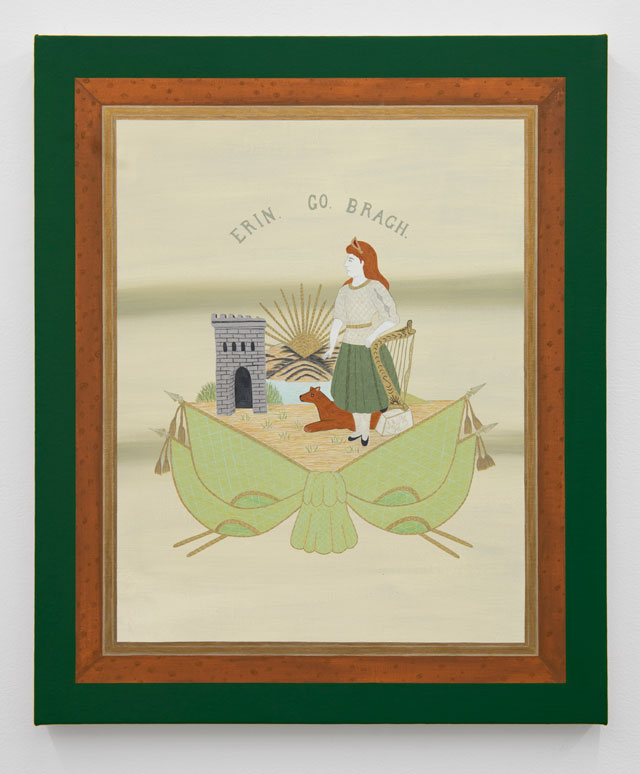
.jpg)
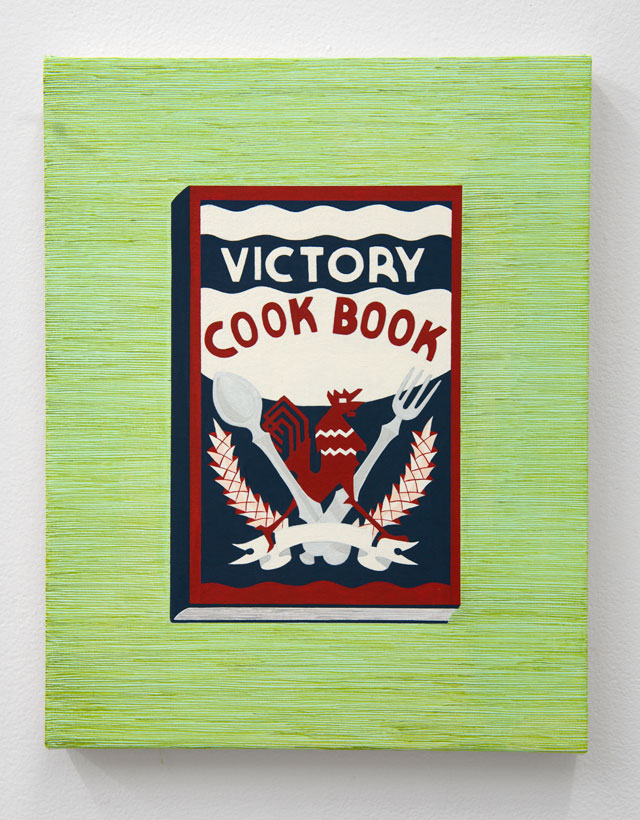
.jpg)
